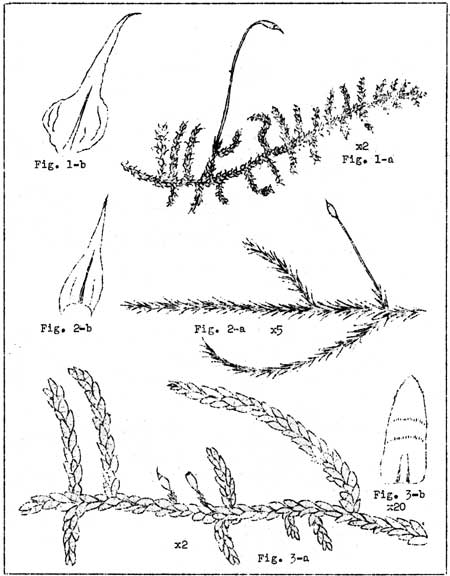
-oOo-

LESKEA FAMILY (LESKEACEAE)
Mosses that are common in the cool, shaded forests of the Canadian
Zone of the park. Their varying habitats include the ground, rocks,
fallen logs, etc., and their deep green color, without any lustre such
as characterized the Plagiothecieae, together with their fern-like
appearance, make them easily recognized. Two subfamilies are represented
- the Thuideae, or the Fern Mosses, and the
Leskeae.
Subfamily (Thuideae)
Mosses characterized by dull green color, stiff stems, irregular to
regular pinnate branching, and inclined capsules.
Claopodium crispifolium (Hook) R. & C. (See Plate XVII,
Fig. 1) grows on stones and soil along the road between en Longmire and
the Nisqually entrance. It differs from C. Bolanderi Best. in its larger
size and the single papillae on the leaf cells, the latter species
having two or more such papillae. C. Bolanderi was collected at about
2000 feet elevation near Ohanapecosh.
Subfamily (Leskeae)
This is a very interesting and widely distributed group of mosses,
many occurring in moist canyons on trunks of shrubs such as stream
alder, and also on soil or stones in loose to densely tufted masses. It
is mostly irregularly branched with capsules usually erect. Most members
are a beautiful deep green in color.
Pseudoleskea rigescens Wils Lindb. (See Plate XVII, Fig. 2.)
was collected on the bark of a dead western white pine near Longmire. It
forms soft interwoven yellow-green mats with leaves gradually long and
tapered (acuminate) narrowly. P. atrovirens (Dicks) Br. Eur. was
found frequently in Van Trump Canyon, also at 5900 feet on Eagle Peak.
The leaves are deep green and the seta reddish brown. P. oligoclada
Kindb. forms rigid tufts and is a yellowish-green in color with
somewhat of a lustre. Perhaps the best identifying characteristic of
this species is the tendency of the branches to assume a cylindric
(julaceous) nature. Collected on the trail to Indian Henry's Hunting
Ground at 3500 feet and again at 5000 feet, also at the base of an
alpine fir on the Eagle Peak saddle.
KEY TO THE SPECIES OF PSEUDOLESKEA
| 1-Medium cells of stem leaves
not much more than twice as long as wide | ...2. |
| 1-Medium cells of stem leaves
at least three or four times as long as wide | ...P.
rigescens. |
| 2-Leaves papillose
on both sides | ...P. atrovirens. |
| 2-Leaves smooth or
papillose only on upper surface and long acuminate | ...P.
oligoclada. |
NECKERA FAMILY (NECKERACEAE)
A small family of mosses, including some very beautiful forms easily
recognized by the flattened (complanate) leaves which are also waved
(undulate) and sufficiently large so that this feature can be detected
with the unaided eye. On Mt. Rainier these mosses grow on the trunks of
trees, branching irregularly to pinnately. The seta is short and the
calyptra cucullate. Two species have been recorded.
Neckera Menziesii Hook has costate leaves that are strongly
undulate and large, being over 3 mm. in length. In color the moss is a
yellowish-green and hangs in loose masses on trees such as the red alder
about Longmire.
N. Douglasii Hook differs from N. Menziesii in its ecostate or
faintly costate leaves which are complanate and strongly undulate. Like
the foregoing species, it is a most attractive form as it hangs in dense
loose masses on tree trunks. It is common on trees around the springs at
Longmire and also at Ohanapecosh. The highest collection was on the
Longmire-Paradise Trail at 3000 feet. (See Plate XVII, Fig. 3).

PLATE XVII.
Fig. 1. (Leskeaceae, subfamily Thuideae). Claopodium crispifolium
Hook. R. & C. 1a - portion of the plant x2. 1b - single leaf
magnified, showing the crisp margin.
Fig. 2. (Leskeaceae, subfamily Leskeae). Pseudoleskea rigescens Wills.
2a - portion of plant x5. 2b - single leaf, magnified.
Fig. 3. (Neckeraceae). Neckera Douglasii Hook. 3a - portion of the
plant showing the complanate nature of the leaf arrangement x2.
3b - leaf x20, showing undulate nature.
Descriptions continued...

